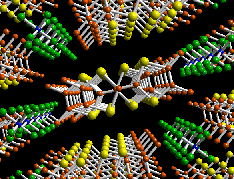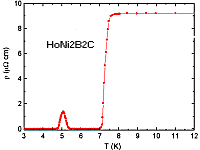Exotic Superconductors
As if ceramic superconductors were not strange enough, much more exotic materials have been synthesized and brought to a superconducting state. Here are some examples.
Organics
Of these exotic superconductors, perhaps the organic-based seem most exotic. Organic conductors include molecular salts, polymers and pure carbon systems. Organic superconductors consist of an electron donor- the planar organic molecule, and an electron acceptor-the non-organic anion. Organic superconductivity was first theorized in 1964 by Bill Little at Stanford, but it wasn't until 1980 that one was synthesized. Since then, over 50 have been found. The critical temperatures for these organic superconductors are quite small- in the range of Type I- but they have very interesting properties. For instance, the critical magnetic field for (TMTSF)2PF6, pictured below, is 6T- many times greater than the critical magnetic field of typical superconductors. These unique properties have fueled a lot of research into organic superconductors, despite the fact that they seem impractical due to their very low Tc.
The first organic superconductor discovered: (TMTSF)2PF6.
One of the pure carbon superconductors is based on the Buckyball- a closed sphere of 60 carbon atoms discovered in 1985. The Buckyball (also called a fullerene) can be doped with alkali metals and made to superconduct at low temperatures. The first was K3C60 in 1991, which has a Tc of 18K. Other, non-spherical carbon-based superconductors are much more recent. Only two years ago, superconductivity was found in single-walled carbon nanotubes at around 15K.
Heavy Fermions
Heavy Fermions are materials, like Borocarbides, which contain rare-earth elements like cerium or ytterbium or actinides like Uranium. Their conduction electrons have effective masses many hundred times greater than normal electrons, giving them low Fermi energy. Many of these materials become superconductive at extremely low temperatures, yet still exhibit magnetic properties. It is into this category that UGe2 and URhGe2 fall, which are discussed in the page on ferromagnetic superconductors. However, these Heavy Fermions have superconductive temperatures less than 10 K, like organics, making them difficult to work with and impractical.
Ruthenates
While on the whole, Ruthenates are a relatively uninteresting group of superconductors, one compound is particularly noteworthy. Ruthenates are related to Type II perovskites, and in particular contain Ruthenium, hence the name. In 1999, a New Zealand scientist Dr. Jef Tallon discovered that the Strontium Ruthenate superconductor he was working with was also a magnet. That wasn't the truly surprising part- ferromagnetic superconductors had been discovered by then. What was truly amazing was the temperature this occurred- 45 K. Since then, he's refined the material and squeezed out a Tc of 58 K. He claims that with further refinement (which has proven tricky), a critical temperature of 100 K should be reached.
Borocarbides
As mentioned earlier, some normal metal conductors don't become superconductive at all: like iron, cobalt or nickel. Many of these are ferromagnetic metals. Also, normal superconductors display perfect diamagnetism- they expel magnetic fields. So, the term "ferromagnetic superconductor" seems like a contradiction. But this is exactly what has been found. These are perhaps the most perplexing of the groups of superconductors discovered to date. Traditional theories of superconductivity do not permit both magnetic and superconductive properties to co-exist. It is thought that the sites of magnetic ions are separate in the crystal lattice from the conduction path, which would allow Cooper pairs to form. These pairs follow superconducting paths that keep them away from the magnetic ions. These ferromagnetic superconductors also have some strange properties. When doped with some exotic elements like Holmium, some of these superconductors retreat to normal resistive states at certain temperatures. This is illustrated below.
Ferromagnetic superconductors are discussed more on the next page.
Main / Introduction / BCS Theory / Type II / Practicality / Exotic / Ferromagnetic / Applications / Sources
™, ©, ®, K&D:
TJ Barry MMIII

